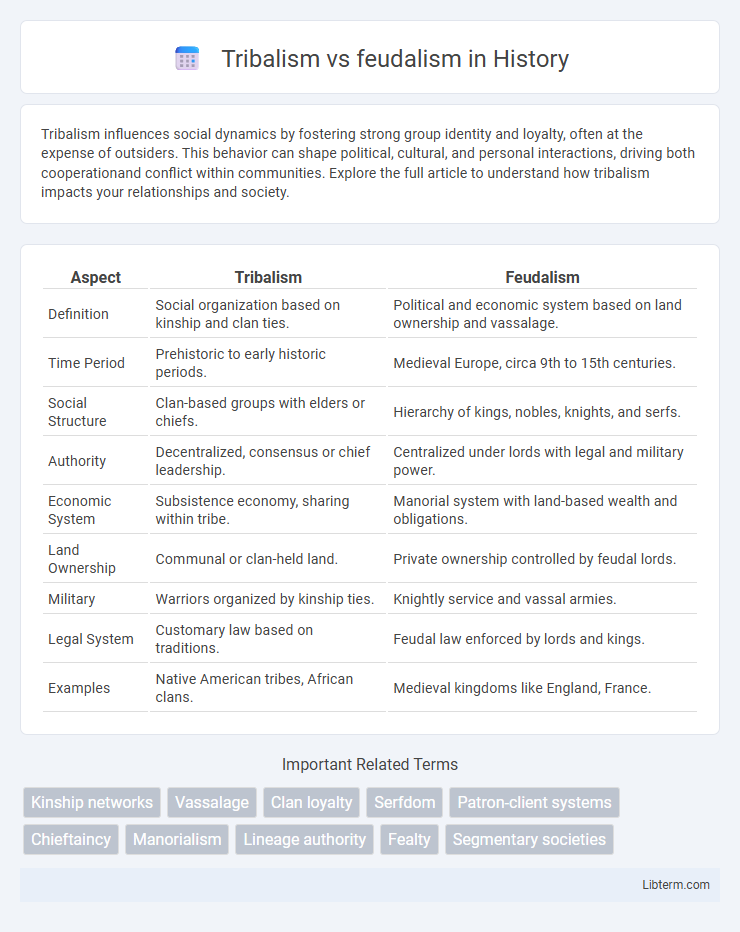Tribalism influences social dynamics by fostering strong group identity and loyalty, often at the expense of outsiders. This behavior can shape political, cultural, and personal interactions, driving both cooperationand conflict within communities. Explore the full article to understand how tribalism impacts your relationships and society.
Table of Comparison
| Aspect | Tribalism | Feudalism |
|---|---|---|
| Definition | Social organization based on kinship and clan ties. | Political and economic system based on land ownership and vassalage. |
| Time Period | Prehistoric to early historic periods. | Medieval Europe, circa 9th to 15th centuries. |
| Social Structure | Clan-based groups with elders or chiefs. | Hierarchy of kings, nobles, knights, and serfs. |
| Authority | Decentralized, consensus or chief leadership. | Centralized under lords with legal and military power. |
| Economic System | Subsistence economy, sharing within tribe. | Manorial system with land-based wealth and obligations. |
| Land Ownership | Communal or clan-held land. | Private ownership controlled by feudal lords. |
| Military | Warriors organized by kinship ties. | Knightly service and vassal armies. |
| Legal System | Customary law based on traditions. | Feudal law enforced by lords and kings. |
| Examples | Native American tribes, African clans. | Medieval kingdoms like England, France. |
Understanding Tribalism: Core Concepts
Tribalism centers on kinship-based social structures where identity, loyalty, and governance are rooted in familial ties and shared ancestry, fostering strong internal cohesion. Unlike feudalism's hierarchical system of land ownership and vassalage, tribal societies emphasize collective decision-making and reciprocal obligations among members. Core concepts of tribalism include kinship networks, clan loyalty, customary law, and the prioritization of group welfare over individual ambitions.
Key Features of Feudalism
Feudalism is characterized by a hierarchical structure where land ownership is the primary source of power, with kings granting land to nobles in exchange for military service and loyalty. The system relies on vassalage, where vassals receive protection and land from their lords while owing service and allegiance in return. Manorialism, a key economic aspect, tied peasants and serfs to the estates controlled by the nobility, creating a rigid social order based on land tenure and reciprocal obligations.
Origins and Historical Contexts
Tribalism originated from kinship-based social structures prevalent in prehistoric and early human societies, emphasizing loyalty to family groups or clans. Feudalism developed in medieval Europe around the 9th century as a hierarchical system where land ownership and vassalage defined political and economic relationships between lords and serfs. While tribalism centers on egalitarian governance within small communities, feudalism institutionalized rigid class stratification within large territorial states.
Social Structures: Tribe vs Feudal Hierarchies
Tribalism organizes society around kinship bonds and communal ownership, with leadership often based on family ties, consensus, and social cohesion within a tribe. Feudalism establishes a rigid hierarchical structure, where social status is determined by land ownership and vassalage, creating layers of lords, vassals, and serfs with clearly defined duties and privileges. Tribal social structures emphasize collective responsibility and equality among members, whereas feudal hierarchies enforce legal and economic dependencies that sustain power imbalances.
Leadership and Authority in Both Systems
Tribalism centers leadership around kinship ties, where authority is often decentralized and based on consensus among elders or clan heads, emphasizing mutual loyalty and shared heritage. Feudalism features a hierarchical system of authority rooted in land ownership, with lords exercising control over vassals through formal obligations and military service. In tribal systems, leadership legitimacy stems from social bonds and traditions, while feudal authority is legitimized by legal contracts and territorial control.
Economic Foundations Compared
Tribalism's economic foundation is primarily based on subsistence agriculture, barter trade, and communal sharing of resources within kinship groups, emphasizing survival and mutual support. Feudalism relies on a hierarchical system where land ownership and control over serfs generate wealth, with lords extracting surplus agricultural production from peasants through labor obligations and tribute. The transition from tribal economies to feudal economies marks a shift from collective resource management to structured economic exploitation tied to land tenure and social stratification.
Land Ownership and Resource Distribution
Tribalism typically features communal land ownership where resources are shared collectively among tribe members, fostering social cohesion and mutual support. Feudalism revolves around a hierarchical system in which land is owned by a monarch or nobility and granted to vassals in exchange for service or labor, concentrating wealth and control in the hands of a few elites. Resource distribution in tribal societies tends to be more egalitarian, whereas feudal systems create distinct economic classes with limited access to land and resources for peasants.
Loyalty and Allegiance: Kinship vs Vassalage
Tribalism centers loyalty and allegiance on kinship bonds, where individuals' obligations are primarily to family and clan members, ensuring mutual protection and support based on shared ancestry. Feudalism, in contrast, is structured around vassalage, where loyalty is formalized through oaths between lords and vassals, creating a hierarchical system of land tenure and military service independent of blood relations. This shift from kin-based allegiance to contractual bonds delineates the fundamental social organization differences between tribal and feudal societies.
Conflict Resolution Mechanisms
Tribalism resolves conflicts primarily through kinship ties and consensus-based decision-making within extended family or clan structures, relying on customs, oral traditions, and mediation by elders to maintain social harmony. Feudalism employs a hierarchical system where lords and vassals settle disputes through legal codes, oaths of loyalty, and fealty obligations, often enforced by local courts or the lord's military power. These contrasting mechanisms reflect tribalism's emphasis on communal relationships versus feudalism's structured legal and military authority for conflict resolution.
Lasting Legacy and Modern Relevance
Tribalism established enduring social bonds based on kinship and customs, influencing modern community identities and informal governance structures. Feudalism's legacy is evident in contemporary property rights, hierarchical institutions, and legal systems rooted in land tenure and vassalage. Both systems persist in shaping cultural cohesion and power dynamics within modern political and social frameworks.
Tribalism Infographic

 libterm.com
libterm.com